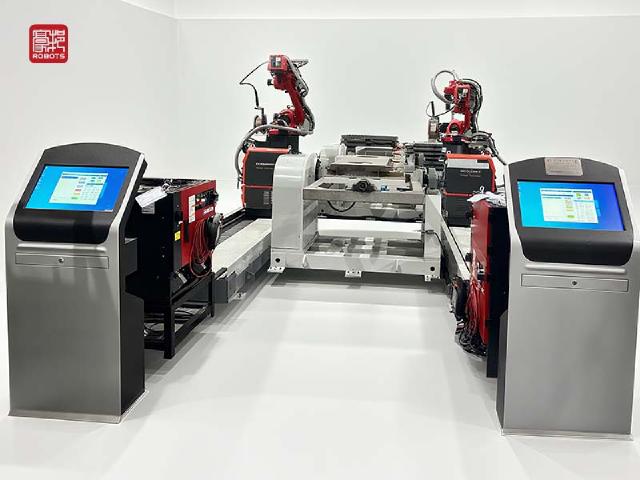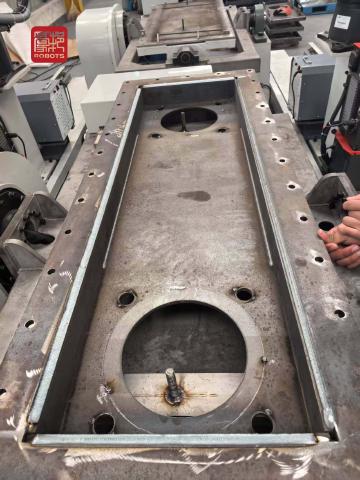Cover plate robot automatic welding equipment
Equipment Introduction

The equipment mainly consists of two sets of robot systems, two sets of positioners, a weld seam tracking system, a teach-free system, a welding system, and a control system. Through the coordinated work of each part, it realizes automatic robot welding and can automatically complete welding tasks according to remote teaching programs without manual intervention in teaching work, which can greatly reduce the labor intensity of operators and equipment operation technical requirements, improve production efficiency and product quality.
Equipment Features
(1) Robot X-axis Movement
Comprising distance sensing devices, servo motors, planetary reducers, precision gears, and racks, this system enables lateral movement controlled by the robot’s external axis, collaborating with the robot to achieve precise welding position alignment.
(2) Dual-axis Positioning Machine
Featuring dual-direction positioning functionality, this system enables double-sided ship-shaped weld seams on workpieces. The robot controls the positioner to automatically flip the workpiece and switch weld positions. The workpiece’s dual-direction rotation is also controlled by the robot.
(3) Weld Tracking System Equipped with a laser weld tracker, it employs intelligent real-time weld tracking technology and a non-contact tracking mode. The system consists of a laser, optical sensors, and a central processor. It scans the positions of points within the laser-illuminated area via sensors, then uses complex algorithms to perform real-time online detection of common welds. It can guide and control the welding gun to precisely position based on measured weld offset, preventing welding defects caused by workpiece position deviations. This ensures safe welding processes and perfect weld formation, while reducing thermal load, improving productivity, maintaining the welding gun in an ideal position, compensating for production tolerances, reducing programming work, and achieving consistent and reproducible welding results. This system is suitable for various specialized welding machines such as straight seam welders, ring seam welders, and welding robots. It includes built-in common weld types and allows for customizable weld types. It also features intelligent and user-friendly functions such as automatic hand-eye calibration and automatic positioning. Below are the parameters for different models of laser weld seam trackers:
(4) Control System Upper-level computer operating system: The working interface displays robot IP, port, and other information, supports scanning to add job names, enables operations such as pause and start, allows viewing of robot logs, and supports adding, moving up, moving down, deleting steps, and calibrating external axes. The automatic workflow includes powering on the equipment, opening the workstation software, positioning and clamping the workpiece, rotating the positioner to the designated welding position, retracting auxiliary equipment to a safe position, retrieving the corresponding program via the host computer, starting the operation, completing the welding, and switching to the next program until all tasks are completed. It also supports one-click startup for continuous welding of multiple welds on the workpiece.
The robot’s X-axis movement is controlled by an external axis control unit and an upper-level computer control system. The equipment’s moving parts use centralized lubrication to extend the service life of moving components and reduce maintenance costs. The entire system adopts external axis control for robots to achieve data interoperability. A safe loading area is designated, with interlocking safety features between the robot and guardrails to ensure a safe operating space during manual loading. Network interfaces are reserved to provide communication data interfaces for future production system upgrades.

Function description
(1) The base serves as the equipment foundation, constructed from welded profiles and subjected to stress-relief annealing treatment;
(2) The equipment’s moving tracks are protected by sheet metal guards to prevent spatter. The welding gun interface is equipped with a robot-mounted dust extraction system to ensure timely exhaust of welding fumes;
(3) The dual-axis positioner uses external axis control. Driven by servo motors and planetary gearboxes, it enables the workpiece to be flipped in both directions to meet welding requirements. The welding fixture consists of a flipping platform, which works with clamping fixtures to position the workpiece.
(4) One-button arc starting and arc extinguishing functions.
(5) New arc tracking function, enabling real-time tracking and adjustment of the welding gun position during the welding process.
(6) Pulse welding machine, meeting the welding process requirements of the workpiece, producing strong and durable welds with minimal spatter and an aesthetically pleasing finish.
(7) Robot external axis control for the slide table movement. The slide table is integrated with the robot for coordinated operation.
(8) The robot is equipped with a horizontal 4-meter movable base. The working radii are 1465 mm and 2010 mm, meeting the requirements of the workpiece.
(9) The equipment is controlled by an upper-level computer control system, with welding parameters programmable and adjustable based on operational conditions. Manual adjustments are made via the controller, ensuring convenient operation.
(10) The welding fixtures for the equipment can be replaced with plate-type fixture structures (implementing single-sided welding correction followed by re-clamping for secondary welding).
Equipment site video

Click here to view the full video effect.